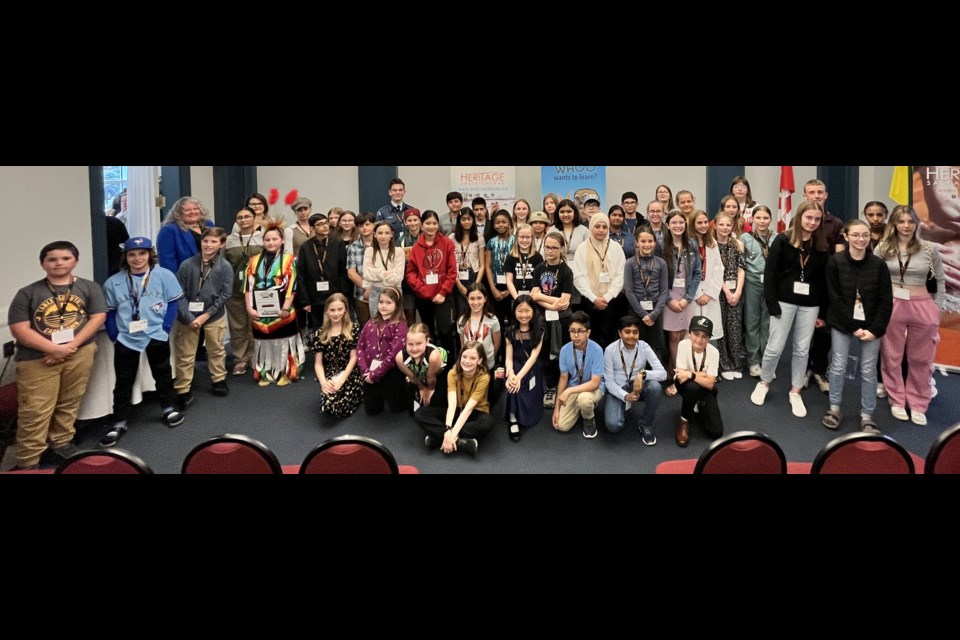The three Moose Jaw-area students who finished in the top 10 at this year’s provincial Heritage Fair are thrilled with how they finished and enjoyed learning about their respective topics.
Moose Jaw’s Camryn Michener (Grade 6) placed first with “The Library Revolution,” followed by Rinoa Harthe Agravante (Grade 6, Moose Jaw) in third for “The Burgess Shale: Strange Creatures of Canada” and Tristan de Jager (Grade 5, Caronport) finishing 10th with “Pier 21: The Gateway to Canada.”
Also, Michener received the Heritage Saskatchewan 15th Anniversary Award and Agravante received the Saskatchewan Archaeological Society Prize.
The Library Revolution
“I’m pretty proud of myself. It’s pretty cool. It just kind of happened,” said Michener, who noted that the win was unexpected. “But yeah, it was pretty exciting.”
The Sunningdale School student focused on Andrew Carnegie, a steel magnate and business tycoon in the 1800s whose ideas revolutionized how libraries functioned. She initially learned about him through a project she created in Grade 4 about the Moose Jaw Public Library.
Before the 19th-century businessman intervened, libraries used to have closed stacks — librarians would collect books for patrons — and would be funded through subscriptions. After the multi-millionaire philanthropist intervened, libraries opened their stacks to patrons and municipalities began funding the venues.
Carnegie helped fund the creation of more than 2,500 libraries worldwide.
Michener added that history is enjoyable because it’s “kind of cool to know what kind of things we went through to get where we are today.”
The Burgess Shale
“I feel really happy. I’m so happy because I’m making my parents proud and my friends too,” said Agravante.
The Westmount School student focused on the Burgess Shale after discovering it in a book and becoming “really fond of it.” Moreover, she wanted to show people that it exists and can be found in Western Canada.
“What attracted me (to it) was the fossils … are over 500 million years old, and that was really interesting because they’re older than the dinosaurs,” the Grade 6 student said.
Through research, she discovered that the Anomalocaris — or “abnormal shrimp” — was the biggest and fiercest arthropod predator of its time. With appendages growing out of its head and an armoured mouth, the 0.6-metre-long (two-foot-long) underwater hunter prowled the seas during the Cambrian period.
Besides the fossils, the Westmount student also focused on Charles Doolittle Walcott, an American paleontologist who discovered in 1909 the Burgess Shale and its 65,000 fossils.
The exciting thing for Agravante was that, after the regional Heritage Fair, her parents took her to Yoho National Park in British Columbia so she could see the Burgess Shale. She then created a video of that trip and presented it with her diorama during provincials.
“It was really cool to touch the actual fossils,” she added.
Pier 21: The Gateway to Canada
“I think I did really good, but I have to thank my family because they helped me a lot,” said de Jager. “I was not really that nervous (attending). I was really excited to be there and excited to get that far. So I just did my best.”
The project was personal for the Grade 5 student, as his paternal grandparents arrived in Canada in the 1950s through Pier 21 in Halifax, N.S.
De Jager’s father acquired a copy of the ship’s passenger list from the Pier 21 Museum, which the youth used in his presentation, along with pictures and information about his grandparents.
Besides learning about his grandparents, the 11-year-old also discovered that Princess Juliana and Prince Bernhard of the Netherlands also passed through Pier 21 during the Second World War. To show their thanks, the royal couple later shipped 100,000 tulip bulbs to Canada; Ottawa now holds an annual festival to honour this occasion.
De Jager added that his project next year may be about either Tim Hortons restaurant or team roping.




